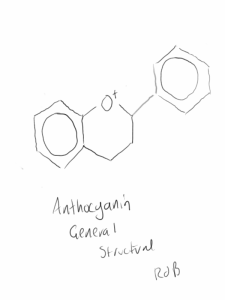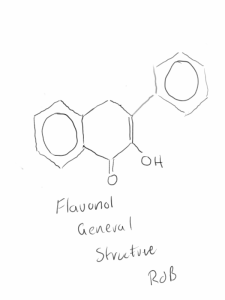Flavonoids are polyphenolic secondary plant metabolites that are bioavailable in humans and have been shown to confer health benefits to those who consume them regularly. In particular, flavonoid consumption is associated with protection from Western lifestyle diseases, and this may may relate to the antioxidant function of flavonoids. Anthocyanins and flavonols are flavonoids which have been shown to be commonly eaten in the diets of humans. As with all polyphenols, anthocyanins and flavonols are characterised by multiple phenol rings containing hydroxyl groups that confer antioxidant potential to the molecules (figure 1 and 2). Anthocyanins are often responsible for the red, blue and purple colours in the skins of fruits and vegetables. Berries are therefore a particularly good sources of anthocyanins, but other plant foods contain sizeable quantities of anthocyanins, including certain cereal grains. The most important dietary flavonol quercetin, but kaempferol is also a quantitatively important flavonol.
Flavonoids are inversely associated with a number of Western diseases including the metabolic syndrome, cardiovascular disease, obesity and type 2 diabetes. The common link between these diseases is that they all involve the development of insulin resistance, a situation that is thought to originate from a poor quality diet devoid of meaningful levels of important nutrients. As well as containing too few essential nutrients such as vitamins and minerals, poor quality diets are also absent of non-essential nutrients such as flavonoids. It has been suggested that the protective effects of flavonoids may relate to an insulin sensitising effect. The association between total and individual flavonoids (flavanones, anthocyanins, flavan-3-ols, polymeric flavonoids, flavonols and flavones) with insulin sensitivity in healthy humans has therefore been investigated1. Both anthocyanins and flavonol intakes were shown to be inversely associated with insulin resistance as measured by the homeostasis model assessment of insulin resistance (HOMA-IR).
In this study, high anthocyanin intakes were also associated with reduced plasma levels of C-reactive protein, whilst high flavonol intakes were associated with higher levels of adiponectin. Therefore anthocyanins are inversely associated with favourable reductions in a systemic inflammation, and flavonols are associated with leanness. Further, high intakes of anthocyanins were also associated with reduced insulin levels. The effects of anthocyanins containing fruits such as berries has been well studied with regard improvements in postprandial blood sugar effects. Berries appear to have beneficial glycaemic effects, that may relate to either their anthocyanin, fibre or natural sugar content. It is not surprising therefore that this study found improvements in insulin function and blood sugar regulation with high intakes of anthocyanins, which are a reliable marker for berry intake. Antioxidant nutrients such as flavonoids may also improve insulin sensitivity through reductions in systemic oxidative stress.
Dr Robert Barrington’s Nutritional Recommendation: The benefits of the flavonoids seen in this study were easily obtainable by levels found in a typical high quality diet (~1.2 grams of total flavonoids per day). Therefore it would appear that dietary levels of certain flavonoids are associated with improved insulin function, reductions in markers for inflammation and increases in markers for low levels of body fat. Of course, the associations in this study and other similar observational studies do not prove cause and effects. It could be the flavonoid intakes are simply a marker for a high quality diet. However, as flavonoids are only found in foods that are of high quality, obtaining high levels of flavonoid containing foods would appear to be prudent, irrespective of the question of causality. The best source of anthocyanins commonly available are berries. The flavonol quercetin is found in tea, wine, onions and apples, whereas the flavonol kaempferol is present in broccoli, endive, brussel sprouts and tea.
RdB


